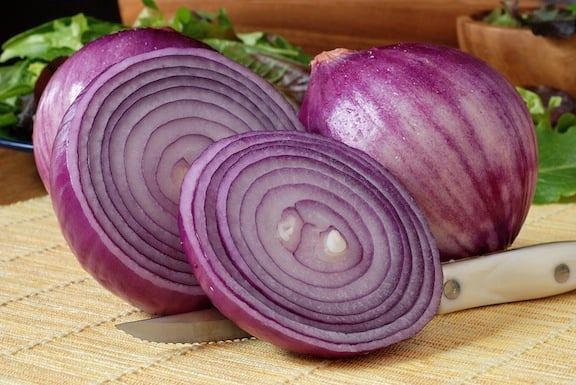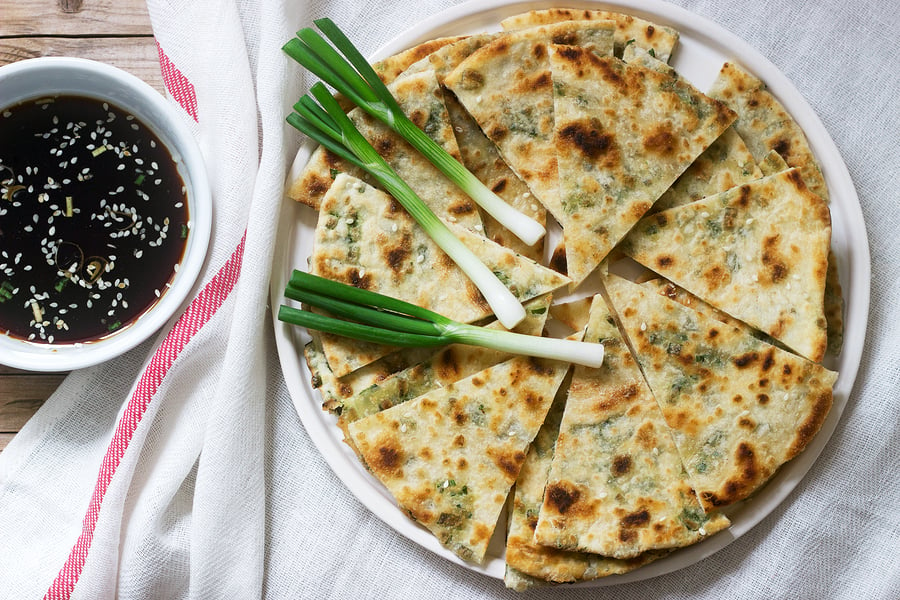Here’s a basic guide to common onion varieties — those most often found in supermarkets, natural foods stores, farm markets, and maybe even your own garden. You’ll find tips on prep and storage, and some easy ways to incorporate more into your daily fare.

Concentric layer on layer of juicy flesh fills an onion’s paper-thin skins. Unruly roots dangle at its base, while the pungent-sweet bulb above holds endless culinary potential.
It’s too bad that most think of onions as only a flavoring element. Their delectable flavor profiles more than qualify them to take the starring role in vegetable dishes.
This information is excerpted and adapted from Melissa’s Great Book of Produce: Everything You Need to Know About Fresh Fruits and Vegetables by Cathy Thomas ©2006, reprinted by permission of Melissa’s Produce.

Though garlic isn’t a type of onion, it’s likewise part of the allium family of vegetables.
3 major onion categories
There are more than five hundred onion varieties, and because onions are easily crossbred, new varieties and hybrids abound. Color, taste, shape, and size vary, but generally speaking, onions fall into three major categories, as follows:
- Storage onions: Those that can be stored for long periods at room temperature are dubbed “storage” onions. They generally have a more pronounced pungency (sometimes described in loving terms as mouth burn or heat).
- Spring onions: Another group, spring onions, includes scallions (green onions), leeks, and Mexican BBQ onions. They have bright green stalks, spoil more quickly, and require refrigeration. Learn more about some members of this category in our Guide to Leeks.
- Sweet onions: Aptly named, these onions have a pronounced sweetness (or lack storage onion heat and have lower acidity). They leave a delicious, very slight pungent aftertaste. They have a shorter shelf life than storage onions but a longer one than green onions.
Why do onions make cooks cry?
Each variety shares a common trait: cutting them releases eye-burning sulfuric compounds. Often, the older the onion, the more eye-irritating it becomes.
Cooks have come up with interesting ways to eliminate onion tears, from wearing goggles to working next to flames to washing onions under cold water. But most agree that working quickly while using a very sharp knife is extremely helpful.

BUYING AND STORING ONIONS
Bulbs should be firm without soft spots. Storage onions and sweet onions should have tightly closed necks; avoid those with green shoulders. Spring onions should have bright green stalks that aren’t wilted or discolored.
Place dry, unwashed storage or sweet onions in loose container (not in plastic bag) in cool, dark location; keep storage onions up to 2 months, sweet onions up to 2 weeks. Or refrigerate sweet onions (keeping them dry) up to 1 month. Unwashed green onions should be refrigerated, kept dry in plastic bag; refrigerate up to 7 days.
Most storage and sweet onion varieties are available year-round.
COMMON ONION VARIETIES
BOILER (gold, red, and white)
Storage onion that is golf-ball sized. Mild pungency Red are sweetest, but whites are most popular.
CIPOLLINE (Italian flat)
Means “small onions” in Italian. Storage onion, generally about 2 inches in diameter, fiat at top and bottom with thin yellow skin. Appealing sharpness balanced with sweet edge.
CIPOLLA
Storage onion. More mature cipolline with diameters about 3 to 4 inches. Crunchier than cipolline and slightly sweeter.
GREEN (scallion or spring)
Spring onion with small, elongated white bulb and long, bright-green stalks. Mild taste. Green stalks have chive-like taste and are often included in recipes. You might wonder why chives aren’t included here; they’re actually classified as herbs. Still, they can be used for much the same purposes.
LEEKS
Leeks often neglected members of the onion family, resemble giant green onions (aka scallions), to which they’re related botanically. Sweeter and somewhat milder than onions. The most tender leeks are quite slender, about the thickness of a thumb, but those are rare. What are most commonly available are plump leeks in bunches of three or four.
MAUI
Sweet onion from Hawaii, grown in volcanic soil. Large with creamy white skin. Juicy and brimming with sweetness. Aftertaste leaves a gentle bite.
MEXICAN BBQ
Look like large green onions with big green stalks and pearl onion—size bulb. There are several onion varieties that fall into this category; all are picked immature with stalks intact. Pungent flavor with underlying sweetness.
PEARL (gold, red, and white)
Storage onion smaller than boiler. Some growers name those with less than I-inch diameters “picklers,” those with 1-inch diameters as “pearls.” Very mild pungency Reds are sweetest, but whites are most popular.
RED (Spanish)
Large storage onion with purplish-red skin. Usually has mild, sweet taste. If using raw, onion has strong sharp taste; place sliced or chopped in colander in sink and pour boiling water on top, then refresh with cold water.
SHALLOTS
Copper-tinged brown skin, parchment thin and brittle, covers the shallot’s milder-than-onion interior. A member of the Allium (onion) genus, it’s formed something like garlic, and is only a little larger, but generally has only 2 to 4 large cloves. Arranged in onion-like layers, shallots are sweeter than onion in both taste and aroma, but can be used interchangeably.
WHITE
Firm storage onions with tightly packed layers. These are mature white boiler onions. Pronounced sharpness and crisp texture.
YELLOW
Most common storage onion, available in medium and large sizes. Brown skin. Thick, juicy layers with pronounced sharpness and crisp texture.
OTHER SWEET ONIONS
Vidalia, Walla Walla, OSO Sweet, Texas Sweet: Texas Sweets are generally softball-size with yellow skin. Vidalia are flat on stem end and round at root end with yellow skin, Walla Walla onions are large and almost round with yellow skin. Sweet and crisp, with very subtle aftertaste.

PREP FOR SWEET & STORAGE ONIONS
For storage onions and sweet onions, trim top and bottom, leaving enough root end intact so that layers stay together. Cut in half lengthwise. Pull off and discard skin. Place cut side down on cutting board. Cut into wedges or slices.
Or, to dice or mince, cut into parallel horizontal lengthwise slices, leaving root end intact (to mince, slices will be closer together); then cut parallel lengthwise vertical slices, leaving root end intact. Cut crosswise.
Peeling pearl onions can be a chore. To make it easier, make a shallow X in stem ends. Boil 5 minutes and drain. Refresh with cold water. When cool enough to handle, pinch at root ends and onions will pop out of skins.

PREP FOR SPRING ONIONS
Wash thoroughly in cold running water. Trim root end. Some recipes call for using green stalks; other do not. Leeks have to be chopped then rinsed well, as intact rings can harbor quite a bit of sandy soil. Dark green leaves are too tough to use, but can be well washed and used in making vegetable broth, then discarded.
ONION NUTRITION INFO
Spring onions are good sources of vitamins A, C, and K. Storage and sweet onions are a significant source of vitamins C and B6. All varieties are low in calories and carbs, as they’re mostly water, but have other notable benefits. See more about the nutrient profile of onions.
BASIC USES FOR ONIONS
Soup starter: Nearly all soups can benefit from a sauté of finely chopped onion before adding liquid and other ingredients.
Soup star: Of course, there’s the famous French onion soup, replete with caramelized onions. See a luscious recipe for Vegan French Onion Soup, complete with characteristic gooey cheese (plant-based, of course).

Roasted: Cut peeled, trimmed sweet onions or red onions into 1-inch-thick crosswise slices. Place in single layer in baking pan greased with olive oil. Brush olive oil on top and sprinkle with chopped fresh thyme leaves. Bake in 375º to 400º F oven until soft, about 30 minutes.
Roast alone or mixed with other vegetables. Especially good with potatoes and sweet potatoes.
To push the concept further, top with vinaigrette (1/2 cup extra-virgin olive oil mixed with 1 tablespoon white wine vinegar or balsamic vinegar, salt to taste, and pinch of dried red chili flakes). Marinate at least 15 minutes. Serve as is as side dish, or chop and stir into sour cream for dip or baked potato topper.

Raw in salads or salsas: Not everyone can tolerate raw onions, but if you’re a fan (and your parter is, too!), use them raw to your heart’s content in all kinds of salads. Red onions, cut into rings or half-rings, are especially appealing when used raw in salads.
Any kind of onion can (and should!) go into making homemade salsa. Chopped fine, red onions make an amazing topper for creamy guacamole.
Caramelized: Heat a combination of vegan butter and vegetable oil in large, deep skillet on medium-high heat. Add sliced (storage or sweet) onion and, if desired, a pinch of sugar; toss to coat. Cook for 4 to 5 minutes, stirring infrequently, so that onions start to soften. Reduce heat to medium or medium-low. Cook until nicely browned, stirring occasionally.
Depending on amount of onion used, this can take 15 to 30 minutes. Season to taste with salt and ground pepper. Use on pizza, polenta, or bruschetta, or in soup or gravy. Delicious tossed into other cooked vegetables, especially mashed potatoes, green beans, or squash.

Savory pancakes: Scallions and other green onions make delectable savory pancakes, inspired by Asian cuisine. Here’s our recipe for Simple Scallion Pancakes.
Grilled Mexican BBQ onions: Cut off roots and most of dark green stalks. Heat barbecue and brush grates with vegetable oil. Grill on medium heat, basting lightly with vegetable oil and seasoning to taste with spicy mixture such as Pico de Gallo seasoning or seasoned salt. Turn and relocate onions on cooler portion of grill from time to time to prevent burning. Grill until tender and nicely browned on both sides (generally about 10 minutes per side).

Slow-baked with a sweet glaze: Amp up the already sweet flavor of storage onions by using in a slow-baked dish with a little added sweetener like maple syrup or agave. See Maple-Glazed Onions and Brussels Sprouts.
Sweet onion syrup: Simply slice a few onions and cook slowly on medium-low heat with olive oil until lightly and evenly browned. A little wine or liquor of your choice can be added to also aid in complimenting and bringing out those juicy flavors. To make into a syrup, puree caramel in a food processor with enough maple syrup or agave to sweeten to your taste.
Onion jam, marmalade, or chutney: Use sweet or storage onion to make delicious condiments. Here’s an easy recipe for onion marmalade and a tasty onion chutney.

Melissa’s Great Book of Produce is available wherever books are sold.
See more of this site’s Good Food Guides.

Leave a Reply